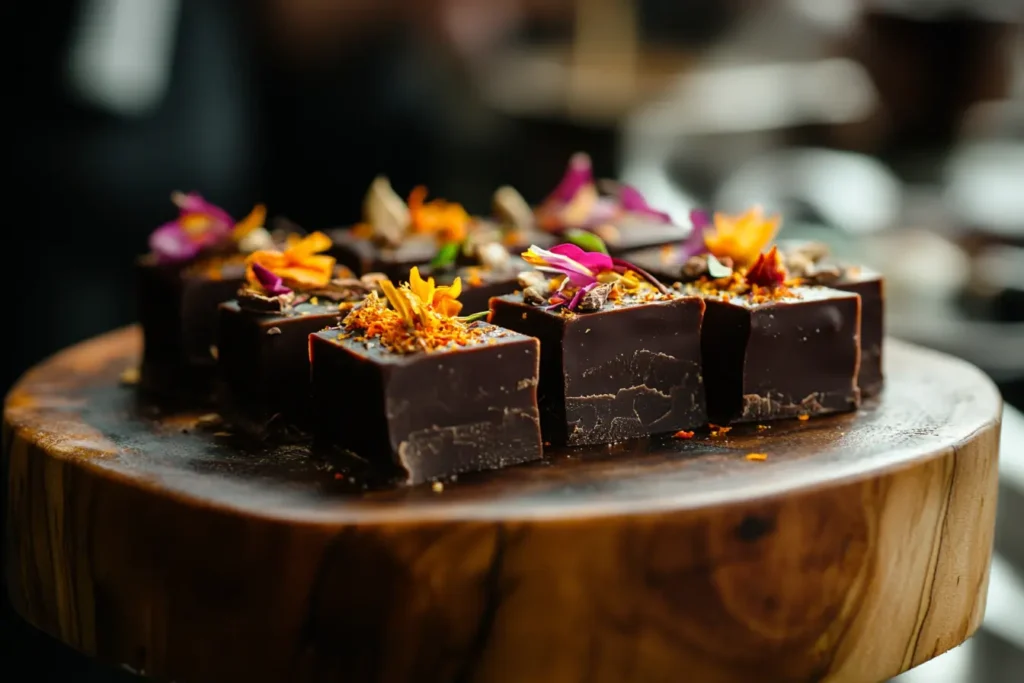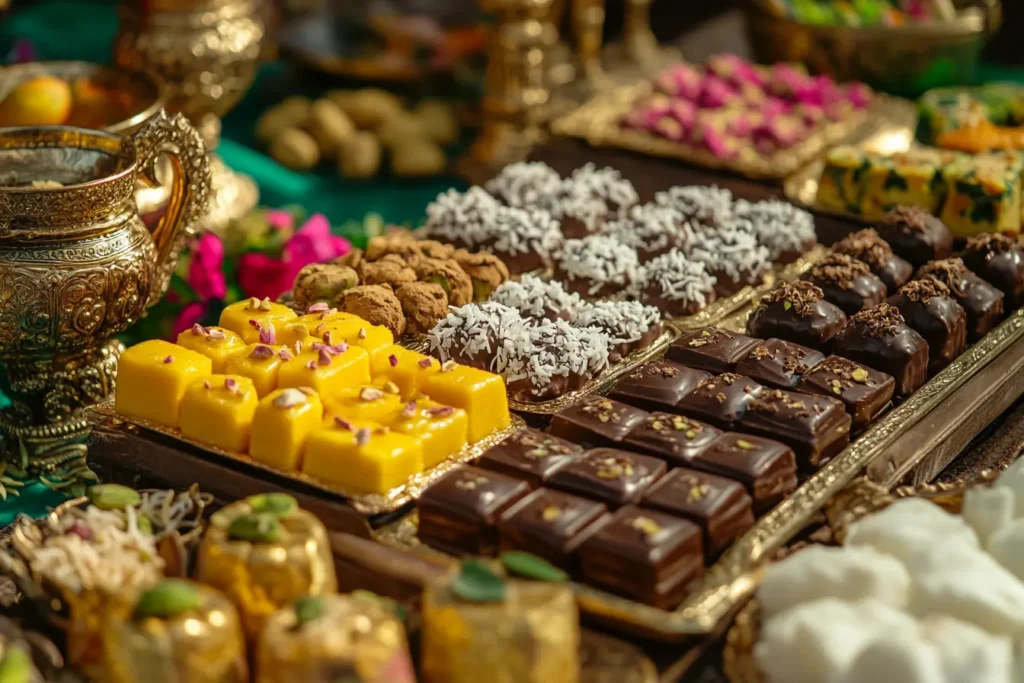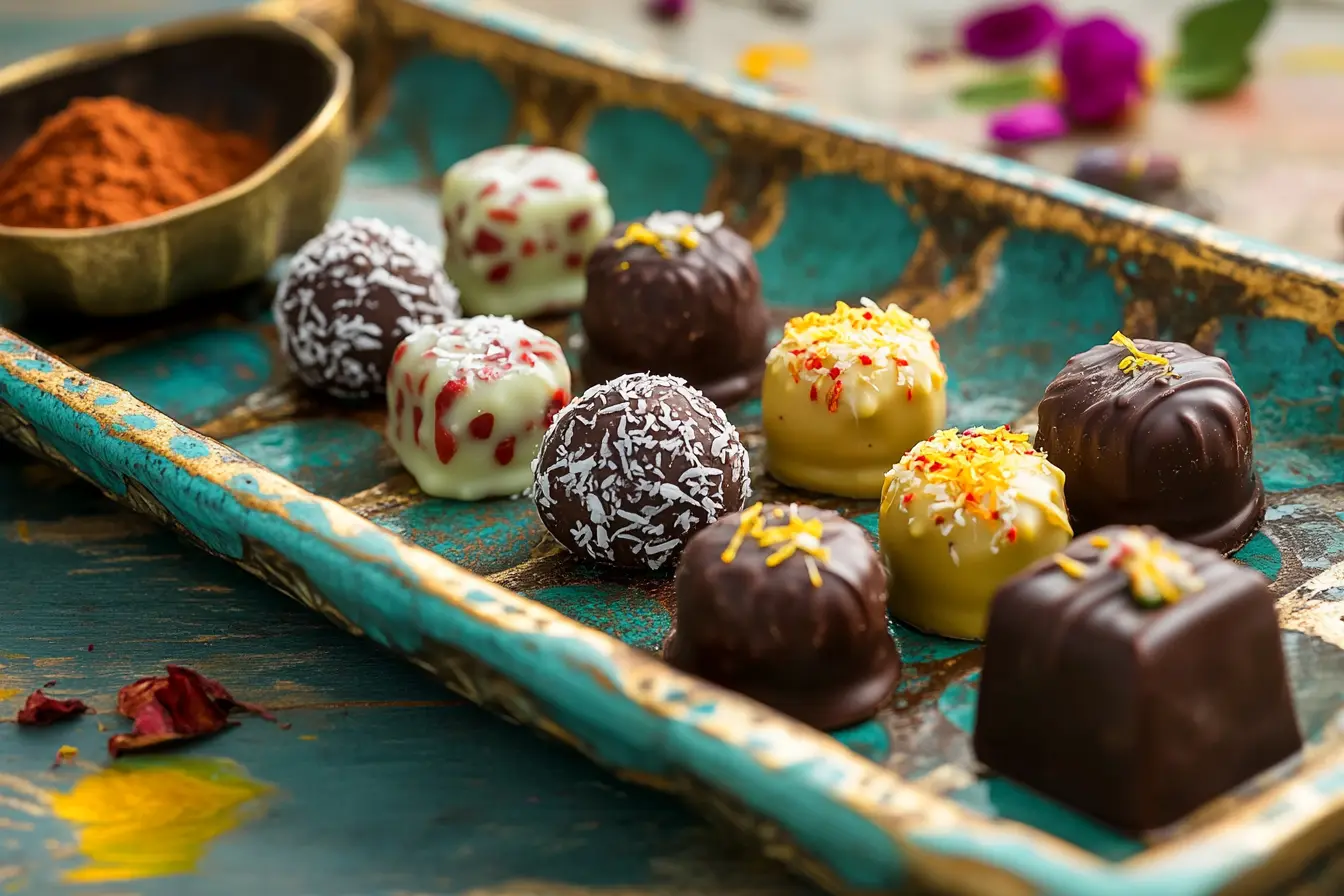The world of chocolates is full of surprises. But have you ever explored the realm of Indian flavor chocolates? This fusion brings together India’s rich culinary traditions and the indulgence of chocolate. With aromatic spices and exotic fruits, these creations offer a unique experience. They celebrate tradition while delighting the taste buds. Let’s take a closer look at their origins and cultural importance.
Introduction to Indian Flavor Chocolates
What Are Indian Flavor Chocolates?
Indian flavor chocolates combine the sweetness of chocolate with traditional Indian tastes. These include cardamom, saffron, chai masala, and even paan. By blending these flavors, chocolatiers have created treats that stand out. Their appeal is growing in both local and global markets.
The Evolution of Chocolate in India
Chocolate wasn’t always a popular treat in India. People traditionally enjoyed sweets like gulab jamun and jalebi. However, over time, global influences introduced chocolate into Indian homes. Chocolatiers soon began mixing Indian spices and flavors into their recipes. This fusion appealed to those who loved both chocolate and traditional sweets.
Cultural Significance of Indian-Inspired Chocolates
Indian flavor chocolates are more than just desserts. They represent culture and tradition. During festivals like Diwali and Raksha Bandhan, these chocolates are now replacing conventional sweets. This shift highlights how modernity and tradition can come together. They also make thoughtful gifts, symbolizing celebration and joy.
Popular Indian Flavors Infused in Chocolates
Spices That Define Indian Flavor Chocolates
India is known for its spices, and they bring boldness and depth to Indian flavor chocolates. Spices like cardamom and saffron create a luxurious aroma and taste. For example, chai masala, with its mix of ginger, cinnamon, and cloves, transforms ordinary chocolate into something unforgettable. These spices not only enhance flavor but also offer health benefits.
Moreover, the spicy twist of red chili in chocolate has gained popularity. It creates an intriguing balance between heat and sweetness, surprising the palate. This daring combination has won fans both in India and abroad.
Fruits and Nuts in Indian Flavor Chocolates
Fruits and nuts are essential in Indian sweets, and their role in chocolates is equally significant. Mango, the “king of fruits,” adds tropical sweetness to chocolates. Likewise, coconut lends a chewy texture and a nutty taste. These ingredients make chocolates irresistible and nostalgic for those familiar with Indian desserts.
Nuts like pistachios and cashews bring a creamy crunch to these treats. Chocolates infused with these elements are perfect for gifting during festivals or enjoying as everyday indulgences. The pairing of nuts and chocolate is not only tasty but also symbolic of abundance in Indian culture.
Regional Specialties and Their Chocolate Counterparts
India’s regional delicacies have inspired some of the most creative chocolates. For instance, paan-flavored chocolates replicate the taste of the traditional betel leaf treat. They combine chocolate with fennel, cardamom, and gulkand (rose petal jam) for a refreshing and sweet experience.
Another example is jaggery chocolates, which use unrefined sugar for an earthy sweetness. These chocolates reflect a rustic charm while offering a healthier alternative to refined sugar treats. Each region brings something unique to the table, ensuring there’s always something new to try.

Leading Brands and Artisans Crafting Indian Flavor Chocolates
Top Indian Chocolate Brands Embracing Traditional Flavors
Several renowned Indian brands have taken the lead in blending chocolate with traditional flavors. For instance, Amul, a household name, has introduced a range of chocolates infused with Indian spices like saffron and cardamom. Similarly, Cadbury India caters to local tastes by creating limited-edition chocolates for festivals, featuring flavors inspired by Indian sweets.
Another noteworthy brand is Nestlé India, which has experimented with unique combinations like coconut and jaggery. These innovations not only appeal to Indian consumers but also showcase the adaptability of global brands to local preferences.
Artisanal Chocolatiers and Their Unique Creations
Beyond large corporations, India is home to talented artisans crafting one-of-a-kind chocolates. Take, for example, Madhu Chocolate, which specializes in infusing Indian spices like chai masala into their creations. Their products are handcrafted with care and cater to those who appreciate high-quality, unique flavors.
Another standout is Manam Chocolate, a brand that combines regional ingredients such as tamarind and rose petals to create innovative confections. Their focus on sustainability and ethical sourcing adds to their appeal, resonating with modern consumers.
If you’re interested in learning more about such artisanal brands, you can explore Madhu Chocolate for their inspiring range of products.
International Recognition of Indian Flavor Chocolates
Indian flavor chocolates have caught the attention of global audiences. Artisans and brands have received accolades at international events, showcasing their creativity and commitment to quality. For instance, Indian chocolatiers have been celebrated for their ability to incorporate bold flavors like chai and paan into premium chocolates.
This growing recognition has opened new avenues for export, with Indian flavor chocolates now available in countries like the U.S. and the U.K. Their presence on global shelves highlights the universal appeal of these distinct treats.
The Making of Indian Flavor Chocolates
Sourcing Ingredients: From Cocoa to Indigenous Spices
The journey of crafting Indian flavor chocolates begins with sourcing the finest ingredients. High-quality cocoa beans are essential, but what sets these chocolates apart is the use of authentic Indian spices and regional ingredients. Spices like saffron, cardamom, and cloves are carefully chosen for their freshness and aroma. Similarly, fruits like mango and coconut are selected based on seasonality to ensure rich and natural flavors.
Ethical sourcing is also a priority for many artisans. For instance, brands focus on partnering with local farmers to obtain fresh spices and nuts. This approach not only guarantees superior quality but also supports sustainable agriculture practices.
Traditional Techniques in Modern Chocolate Crafting
Blending tradition with innovation is key to creating these unique chocolates. Chocolatiers use modern machinery for precision but often rely on traditional methods for flavor blending. For example, spices are roasted and ground to enhance their natural oils, ensuring they meld perfectly with the chocolate.
Artisans also adapt regional culinary techniques to the chocolate-making process. The preparation of gulkand (rose petal jam) for paan-flavored chocolates is one such example. This meticulous attention to detail ensures that the final product retains the essence of its Indian roots.
Challenges in Balancing Flavors and Textures
Creating a perfect balance between robust Indian flavors and the smoothness of chocolate is no easy feat. Spices like red chili or ginger can easily overpower the chocolate, making precise measurements crucial. Similarly, achieving the right texture when incorporating ingredients like pistachios or jaggery requires experimentation and expertise.
Chocolatiers must also address the challenge of preserving these flavors over time. Innovative packaging and storage solutions are employed to maintain the freshness and integrity of the ingredients.
Market Trends and Consumer Preferences
Rising Popularity of Indian Flavor Chocolates
The demand for Indian flavor chocolates is skyrocketing. A growing number of consumers seek unique and culturally rich treats, making these chocolates a popular choice. They offer an exciting alternative to conventional sweets, especially during festivals like Diwali and Holi.
Market reports highlight the increasing sales of artisanal and regionally inspired chocolates. This trend reflects a shift toward products that celebrate local heritage. Additionally, social media buzz and gifting culture are playing significant roles in boosting the appeal of these innovative confections.

Health Considerations and Nutritional Aspects
Health-conscious consumers are also embracing these chocolates due to their use of natural ingredients. Spices like turmeric and ginger are not only flavorful but also known for their health benefits. For instance, turmeric is celebrated for its anti-inflammatory properties, while cardamom aids digestion.
Furthermore, many brands are now offering options with jaggery or reduced sugar, catering to those looking for guilt-free indulgence. These chocolates strike a balance between indulgence and wellness, making them suitable for a wider audience.
Future Prospects: Innovations and Emerging Flavors
The future of Indian flavor chocolates is brimming with possibilities. Artisans and brands are continually experimenting with new combinations, such as tamarind-infused dark chocolate or coconut jaggery truffles. These innovations aim to captivate both local and global markets.
In addition, the use of regional specialties, like millets and herbal infusions, is on the rise. These ingredients not only add to the flavor profile but also align with the growing trend of sustainable and health-conscious eating.
Frequently Asked Questions (FAQs)
Several brands offer exquisite Indian flavor chocolates. From mainstream options like Cadbury Silk with cardamom to artisanal creations by Madhu Chocolate, there’s a wide variety to explore. You’ll find flavors like chai masala, paan, and even mango chili. These chocolates are available both online and in specialty stores, making them accessible to everyone.
Indian spices like cardamom, saffron, and ginger elevate the flavor of chocolates by adding depth and complexity. These spices introduce unique notes that contrast and complement the sweetness of chocolate. For instance, the warmth of chai masala creates a cozy and aromatic experience, while red chili adds a spicy twist that surprises the palate.
Yes, many Indian flavor chocolates are now available internationally. Artisanal brands and online retailers ship these unique creations to various countries, including the U.S., U.K., and Australia. This global reach highlights the universal appeal of their bold and exotic flavors.
Absolutely! Making Indian flavor chocolates at home is a fun and creative process. You can melt your favorite chocolate and mix in spices like cinnamon or cardamom. For a fruity twist, add dried mango or shredded coconut. Experimenting with combinations allows you to customize the flavors to your liking.
The spices used in Indian flavor chocolates are not only tasty but also packed with health benefits. For example, turmeric has anti-inflammatory properties, while ginger supports digestion. These chocolates combine indulgence with wellness, making them a delightful yet healthier treat.
Brands like Amul and Nestlé India are pioneers in offering chocolates with traditional flavors. Artisanal chocolatiers such as Madhu Chocolate and Manam Chocolate also stand out for their creative use of spices and regional ingredients. These brands celebrate India’s rich culinary heritage through their innovative products.

